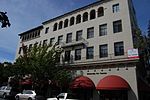Bike Arc

Bike Arc LLC, located in downtown Palo Alto, California, is a Silicon Valley startup that designs secure bicycle parking racks and systems. It was founded by Joseph Bellomo and Jeff Selzer in 2008. Jeff Selzer sits on the Board of Directors of the Silicon Valley Bicycle Coalition and is the General Manager of Palo Alto Bicycles. Joseph Bellomo, a California-licensed architect, is the founder and owner of Joseph Bellomo Architects, Inc. in Palo Alto, which he founded in 1986. In addition to collaborating on Bike Arc, Mr. Bellomo and Mr. Selzer also worked together on the Palo Alto Bikestation at the Caltrain depot. In 2009, the American Institute of Architects, California Council, gave Bike Arc the Honor Award for Small Projects.
Excerpt from the Wikipedia article Bike Arc (License: CC BY-SA 3.0, Authors, Images).Bike Arc
University Avenue, Palo Alto
Geographical coordinates (GPS) Address Nearby Places Show on map
Geographical coordinates (GPS)
| Latitude | Longitude |
|---|---|
| N 37.4433 ° | E -122.1634 ° |
Address
University Avenue 102
94301 Palo Alto
California, United States
Open on Google Maps







